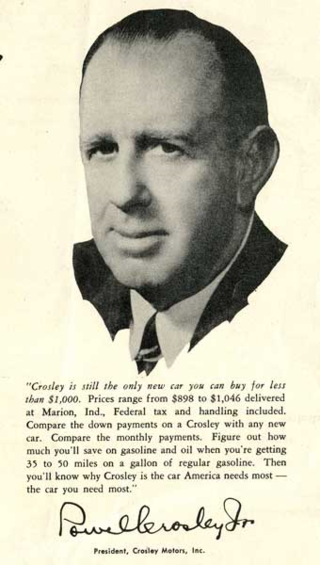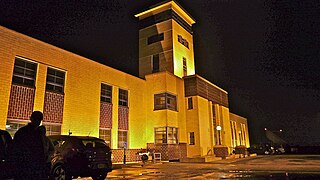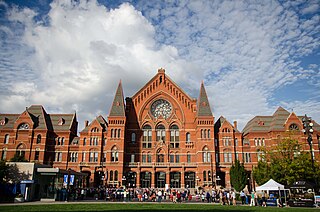
Norwood is the third most populous city in Hamilton County, Ohio, United States, and an enclave of the larger city of Cincinnati. The population was 19,043 at the 2020 census. Originally settled as an early suburb of Cincinnati in the wooded countryside north of the city, the area is characterized by older homes and tree-lined streets.

WLW is a commercial news/talk radio station licensed to Cincinnati, Ohio. Owned by iHeartMedia, WLW is a clear-channel station, often identifying itself as The Big One.

Powel Crosley Jr. was an American inventor, industrialist, and entrepreneur. He was also a pioneer in radio broadcasting, and owner of the Cincinnati Reds major league baseball team. In addition, Crosley's companies manufactured Crosley automobiles and radios, and operated WLW radio station. Crosley, once dubbed "The Henry Ford of Radio," was inducted into the Automotive Hall of Fame in 2010 and the National Radio Hall of Fame in 2013.

WLWT is a television station in Cincinnati, Ohio, United States, affiliated with NBC and owned by Hearst Television. The station's studios are located on Young Street, and its transmitter is located on Chickasaw Street, both in the Mount Auburn neighborhood of Cincinnati.
The Crosley Broadcasting Corporation was a radio and television broadcaster founded by radio manufacturing pioneer Powel Crosley, Jr. It had a major influence in the early years of radio and television broadcasting, and helped the Voice of America carry its message around the world.

The Voice of America's Bethany Relay Station was located in Butler County, Ohio's Union Township about 25 miles (40 km) north of Cincinnati, adjacent to the transmitter site of WLW. Starting in 1944 during World War II it transmitted American radio programming abroad on shortwave frequencies, using 200,000-watt transmitters built by Crosley engineers under the direction of R.J. Rockwell. The site was developed to provide 'fallback' transmission facilities inland and away from the East Coast, where transmitters were located in Massachusetts, on Long Island in New York, and in New Jersey, all close to the ocean, subject to attack from German submarines or other invading forces.

Carew Tower is a 49-story, 574-foot (175 m) Art Deco building completed in 1930 in the heart of downtown Cincinnati, Ohio, overlooking the Ohio River waterfront. The structure is the second-tallest building in the city, and it was added to the register of National Historic Landmarks on April 19, 1994. The tower is named after Joseph T. Carew, proprietor of the Mabley & Carew department store chain, which had previously operated in a building on the site.

Music Hall, commonly known as Cincinnati Music Hall, is a classical music performance hall in Cincinnati, Ohio, completed in 1878. It serves as the home for the Cincinnati Ballet, Cincinnati Symphony Orchestra, Cincinnati Opera, May Festival Chorus, and the Cincinnati Pops Orchestra. In January 1975, it was recognized as a National Historic Landmark by the U.S. Department of the Interior for its distinctive Venetian Gothic architecture. The building was designed with a dual purpose – to house musical activities in its central auditorium and industrial exhibitions in its side wings. It is located at 1241 Elm Street, across from the historic Washington Park in Over-the-Rhine, minutes from the center of the downtown area.

First National Center, formerly known as First National Bank Building, is a prominent mixed-use skyscraper in downtown Oklahoma City. The art deco tower is 406 feet tall at the roof, and is 446 feet at its spire and contains 33 floors. The building was constructed in 1931 by the First National Bank and Trust Company of Oklahoma City and has 990,000 square feet (92,000 m2) of office space.

Gwynne Building is a registered historic building in Cincinnati, Ohio, listed in the National Register on August 3, 1979.

Walnut Hills United Presbyterian Church is a historic church tower in the Walnut Hills neighborhood of Cincinnati, Ohio, United States. The last remnant of a landmark church building, it was designed by a leading Cincinnati architect and built in the 1880s. Although named a historic site a century after its construction, the building was mostly destroyed after extensive neglect caused restoration to become prohibitively expensive.

The Campana Factory is a historic building in Batavia, Illinois. It was built in 1936 to serve as a factory for The Campana Company, which produced Italian Balm, the most popular hand lotion in the United States during The Great Depression. The Streamline Moderne and Bauhaus building features many innovative technologies, such as air conditioning. It was added to the National Register of Historic Places in 1979.

The Hope Village Historic District is a historic rural mill settlement within Hope Village in Scituate, Rhode Island. Hope Village is located on a bend in the North Pawtuxet River in the southeastern corner of Scituate. Industrial activity has occurred in Hope Village since the mid-eighteenth century. Surviving industrial and residential buildings in the Historic District date back to the early 19th century. The village center sits at junction of Main Street and North Road. Hope Village radiates out from the center with houses on several smaller side streets in a compact configuration. Currently there is little commercial or industrial activity in Hope Village and none in the Historic District. The present stone mill building on the south side of Hope Village was built in 1844 by Brown & Ives of Providence, expanded in 1871 and modified in 1910. Approximately one quarter of the village's current housing stock was built as mill worker housing by various owners of Hope Mill.

The Atlanta Biltmore Hotel and Biltmore Apartments is an historic building located in Atlanta, Georgia. The complex, originally consisting of a hotel and apartments, was developed by William Candler, son of Coca-Cola executive Asa Candler, with Holland Ball Judkins and John McEntee Bowman. The original hotel building was converted to an office building in 1999. The building is currently owned by the Georgia Institute of Technology and is adjacent to Technology Square.

Frederick W. Garber was an American architect in Cincinnati, Ohio and the principal architect in the Garber & Woodward firm with Clifford B. Woodward (1880–1932). The firm operated from 1904 until it was dissolved in 1933 Their work has been described as in the Beaux-Arts tradition and included buildings on the University of Cincinnati campuses, schools, hospitals, commercial buildings, "fine residences" and public housing.

The American Can Company Building, now known as the American Can Lofts, is a historic former factory in the Northside neighborhood of Cincinnati, Ohio, United States. Built in 1921, it is a concrete building with a concrete foundation; five stories tall, it has a total floor space of approximately 180,000 square feet (17,000 m2). Built by the American Can Company, the factory was used to manufacture can-making machines, rather than producing the cans itself; it remained in operation until closure in 1963. Two years later, it was reopened by the Cleveland Machine Company, which used its first floor for machining purposes; after their departure in 1978, it sat almost totally unused, with the only exceptions being small businesses such as T-shirt printers and warehouse operators.

The Ash Street School is a historic schoolhouse in Manchester, New Hampshire. It has been listed on the National Register of Historic Places since 1975. The school occupies the city block bounded by Ash, Bridge, Maple, and Pearl Streets.

The Provo Third Ward Chapel is a historic building located in Provo, Utah. It was listed on the National Register of Historic Places on April 2, 1979.

Seagate, also known as the Bay Club, is located along Sarasota Bay in Manatee County, Florida, and was the former winter estate of Powel Crosley Jr., a noted Cincinnati, Ohio, industrialist and entrepreneur. Crosley had the 11,000-square-foot (1,000 m2), Mediterranean Revival-style home built in 1929 for his wife, Gwendolyn, on 45-acre (18-hectare) of land along Sarasota Bay that was platted in 1925 for a failed subdivision. New York architect George Albree Freeman Jr. designed the home; Ivo A. de Minicis, a Tampa, Florida, architect, drafted the plans; and Paul W. Bergmann, a Sarasota contractor, reportedly built the 2+1⁄2-story, cast-stone-and-stucco home in 135 days. Gwendolyn Crosley died at Seagate in 1939. After allowing the Army Air Corps to use the home for airmen who were training at a nearby airbase during World War II, Crosley sold the property in 1947. Freeman Horton and his wife, Mabel, bought it the following year. The Horton family lived on the estate from 1948 to 1977. The Campeau Corporation of America acquired the property in the early 1980s, intending to develop it into condominium units and use the residence serving as the development's clubhouse, but its plans failed. The Crosley home and 45 acres of adjacent property were formally added to the National Register of Historic Places on January 21, 1983.

The Commercial Exchange Building, also known as the Collins Manufacturing – Jackson Automobile Company complex, is an industrial building complex located at 2301 E. Michigan Ave. in Jackson, Michigan. The building was built partly in 1895, and was listed on the National Register of Historic Places in 1993. The listing included four contributing buildings.





















